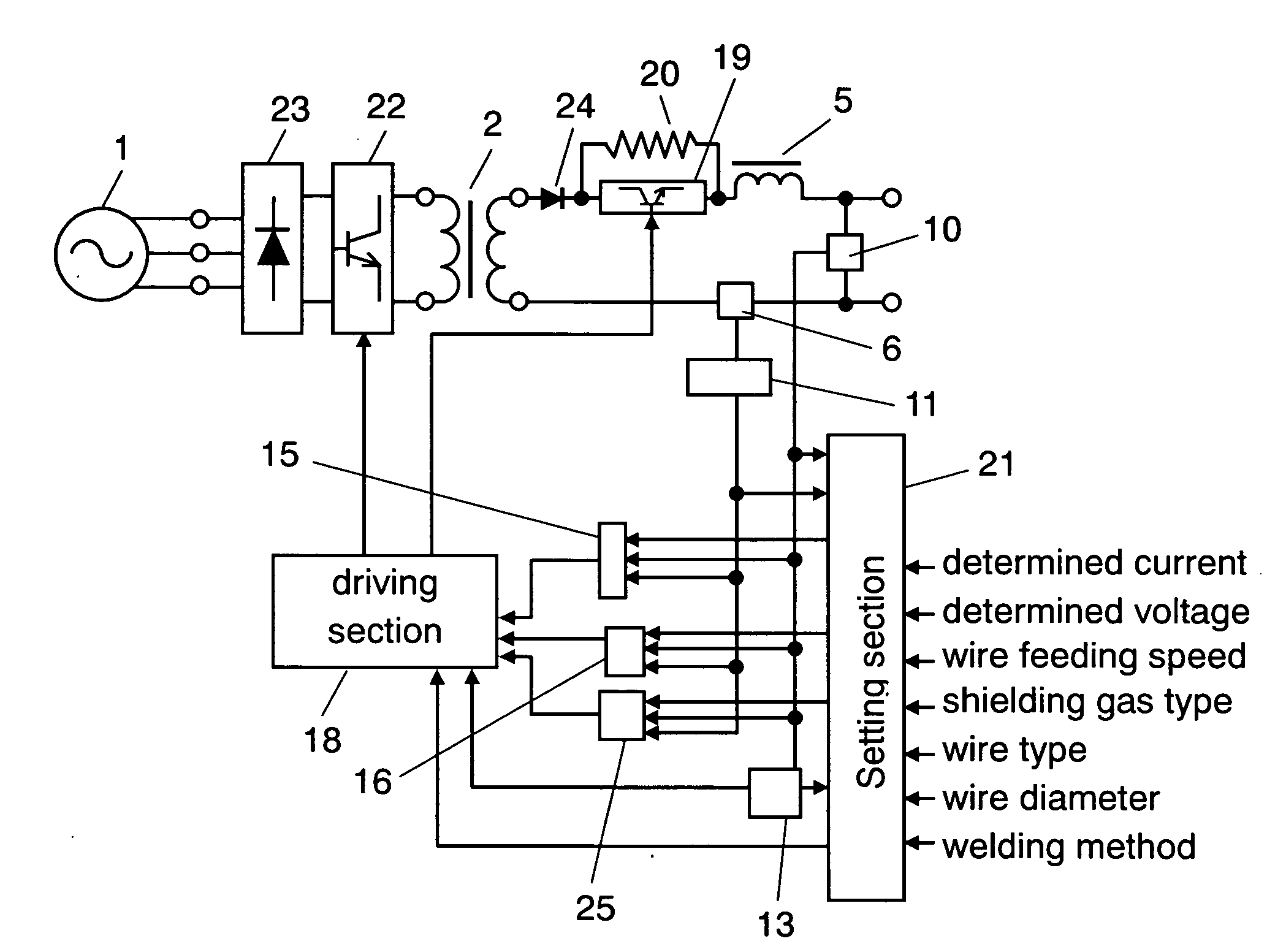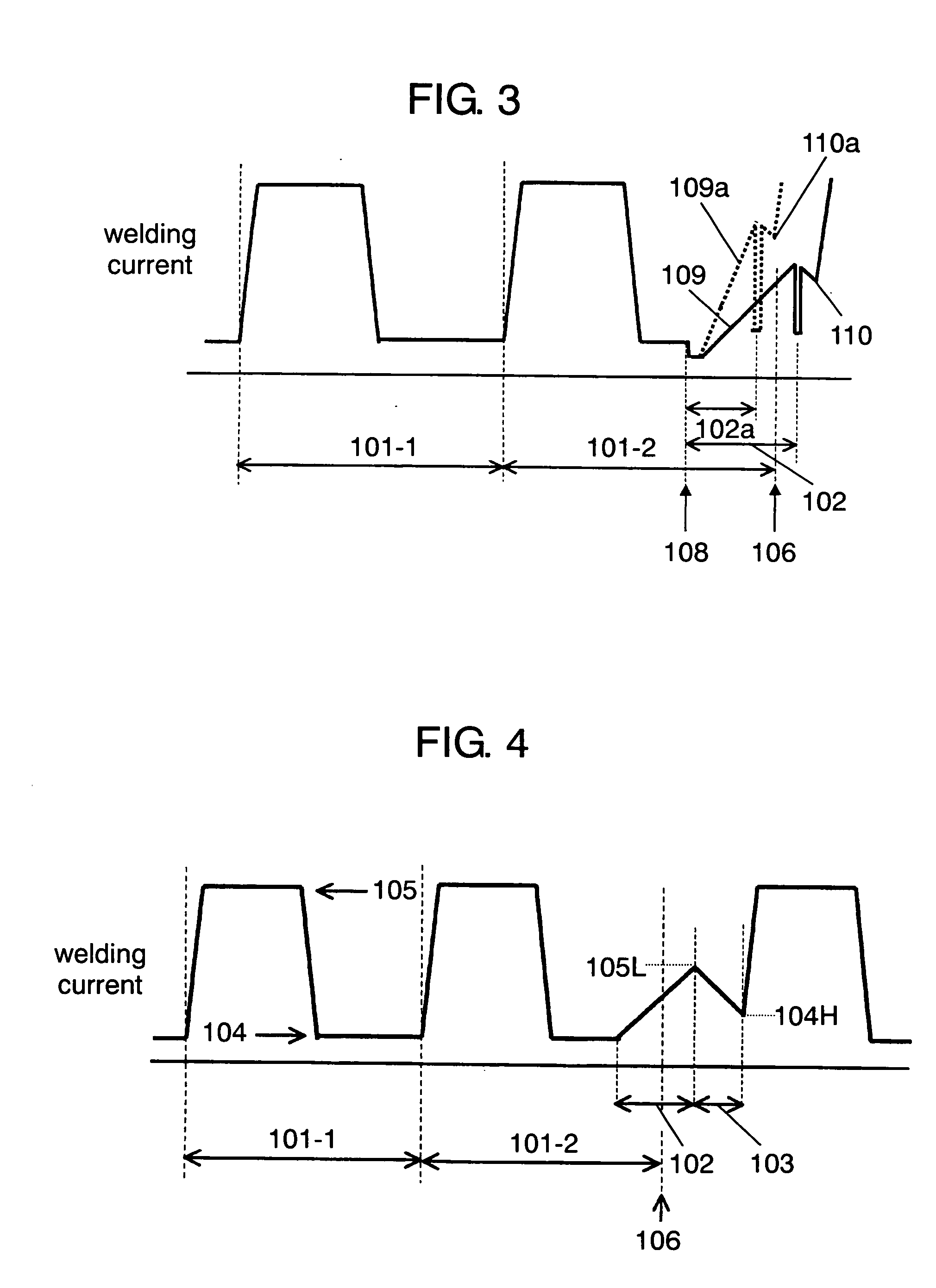Pulse arc welding control method and pulse arc welding device
- Summary
- Abstract
- Description
- Claims
- Application Information
AI Technical Summary
Benefits of technology
Problems solved by technology
Method used
Image
Examples
first exemplary embodiment
[0062]Hereinafter will be described the structure of the first exemplary embodiment with reference to FIGS. 1 and 2. In the drawings, the same parts as those shown in FIG. 4 that illustrates a control method employed for a conventional pulse arc welding device described in Background Art are designated by similar marks, and a detailed explanation thereof will be omitted.
[0063]FIG. 1 schematically shows the structure of the arc welding device of the first exemplary embodiment. In the arc welding device of the present invention, input power supply 1 is connected to primary rectifying element 23 that rectifies the output of input power supply 1. Receiving the output from primary rectifying element 23, primary switching element 22 controls welding output. Receiving the output from primary switching element 22, transformer 2 provides power conversion. Secondary rectifying element 24 rectifies the secondary output of the transformer. Secondary switching element 19 is connected in series w...
second exemplary embodiment
[0074]Here will be described the control method of the pulse arc welding device of the second exemplary embodiment with reference to FIG. 1 and FIG. 2. In the embodiment, the same parts as those of the structure described in the first exemplary embodiment are designated by similar marks, and a detailed explanation thereof will be omitted.
[0075]The control method of the second embodiment differs from that of the first embodiment in that secondary controller 25 controls switching element 19 so as to sharply decrease welding current not only when a short circuit is recovered but also when a short circuit occurs.
[0076]In arc welding, generally, the higher the welding current value when a short circuit occurs, the larger the amount of spatters. In the welding device of the embodiment, on detecting a short circuit, arc short-circuit judging section 13 sends a short-circuit detecting signal to setting section 21. In response to the signal, setting section 21 immediately outputs a parameter...
third exemplary embodiment
[0080]Here will be described the control method of the pulse arc welding device of the third exemplary embodiment with reference to FIG. 3. In the embodiment, the same parts as those of the structure described in the first exemplary embodiment are designated by similar marks, and a detailed explanation thereof will be omitted. The control method of the third embodiment differs from the method described in the first embodiment in that, according to the condition of a short circuit, setting section 21 changes the gradient of a waveform of current applied for recovering from a short-circuit, as shown in FIG. 3. The detailed description will be given later. The dotted lines in FIG. 3 show a case where a waveform with a steeper gradient is applied to recover from a short circuit.
[0081]Hereinafter will be described the control method of the pulse arc welding device of the embodiment. The description is firstly given on an example in which pulse rise time has a delay due to the occurrence ...
PUM
| Property | Measurement | Unit |
|---|---|---|
| Length | aaaaa | aaaaa |
| Current | aaaaa | aaaaa |
Abstract
Description
Claims
Application Information
 Login to View More
Login to View More - R&D
- Intellectual Property
- Life Sciences
- Materials
- Tech Scout
- Unparalleled Data Quality
- Higher Quality Content
- 60% Fewer Hallucinations
Browse by: Latest US Patents, China's latest patents, Technical Efficacy Thesaurus, Application Domain, Technology Topic, Popular Technical Reports.
© 2025 PatSnap. All rights reserved.Legal|Privacy policy|Modern Slavery Act Transparency Statement|Sitemap|About US| Contact US: help@patsnap.com



